 I have a big love for all of the annual plants that are available to augment my garden. Many of them come from tropical climates. One of the most popular annual plants of all time is impatiens walleriana. This plant grows readily in the heat, and covers itself with self cleaning flowers in a wide range of colors. Impatiens also tolerates a good bit of shade. They are happy in the sun, given sufficient water. They are the workhorse of annual shade bedding plants. That said, the impatiens are sick. A fungal disease that causes the plants to collapse in a rotten mess has infected our area. This picture, taken in 2009, at the one place I plant impatiens, tells the tale. I was so sure the client was over watering. I know now the plants were diseased. This devastating disease has affected impatiens plants all over the globe. There has been lots of discussion about planting impatiens this year in my area. I believe those major growers who are brave enough to suggest the disease is currently inherent in the seed. The upshot-should you find a nursery this season who still offers impatiens for sale, be advised that your purchase comes with an expiration date. Preventative applications of fungicide may stave off the disease, but once the disease is present, there is no cure. Any places planted with impatiens last year should not be replanted with them this year. No matter how much you love impatiens, the look of the plants in the picture above is not a good look.
I have a big love for all of the annual plants that are available to augment my garden. Many of them come from tropical climates. One of the most popular annual plants of all time is impatiens walleriana. This plant grows readily in the heat, and covers itself with self cleaning flowers in a wide range of colors. Impatiens also tolerates a good bit of shade. They are happy in the sun, given sufficient water. They are the workhorse of annual shade bedding plants. That said, the impatiens are sick. A fungal disease that causes the plants to collapse in a rotten mess has infected our area. This picture, taken in 2009, at the one place I plant impatiens, tells the tale. I was so sure the client was over watering. I know now the plants were diseased. This devastating disease has affected impatiens plants all over the globe. There has been lots of discussion about planting impatiens this year in my area. I believe those major growers who are brave enough to suggest the disease is currently inherent in the seed. The upshot-should you find a nursery this season who still offers impatiens for sale, be advised that your purchase comes with an expiration date. Preventative applications of fungicide may stave off the disease, but once the disease is present, there is no cure. Any places planted with impatiens last year should not be replanted with them this year. No matter how much you love impatiens, the look of the plants in the picture above is not a good look.
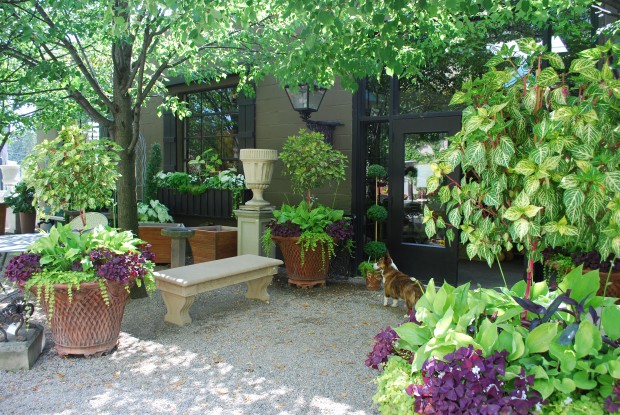 The list of annual and tropical plants that tolerate shady locations is considerable. The toughest part is getting past the fact that a favorite plant in a favorite color is not available. On the positive side, adverse conditions can produce some very interesting and creative results. Green shade plants such as the irisine standards pictures, hostas, creeping jenny are not prized for their flowers, but the leaves are strikingly colorful. The same goes for the oxalis and Moses in the cradle. The flowers are not so showy, but the leaf color is spectacular.
The list of annual and tropical plants that tolerate shady locations is considerable. The toughest part is getting past the fact that a favorite plant in a favorite color is not available. On the positive side, adverse conditions can produce some very interesting and creative results. Green shade plants such as the irisine standards pictures, hostas, creeping jenny are not prized for their flowers, but the leaves are strikingly colorful. The same goes for the oxalis and Moses in the cradle. The flowers are not so showy, but the leaf color is spectacular.
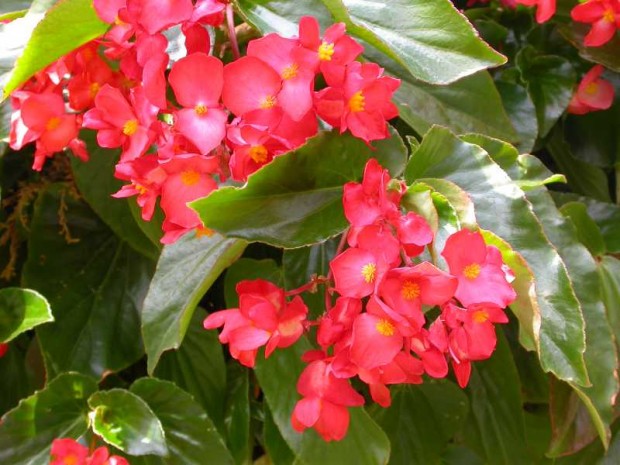 Dragon wing begonias are quite tolerant of shade, though the colors tend towards the yellow reds, coral and orange-not at all like the bluish pinks so common in impatiens. The appearance of the color of this plant has everything to do with the color of its companion plants. Yellow will make this flower appear more coral orange. A red violet companion makes this begonia appear more rose red.
Dragon wing begonias are quite tolerant of shade, though the colors tend towards the yellow reds, coral and orange-not at all like the bluish pinks so common in impatiens. The appearance of the color of this plant has everything to do with the color of its companion plants. Yellow will make this flower appear more coral orange. A red violet companion makes this begonia appear more rose red.
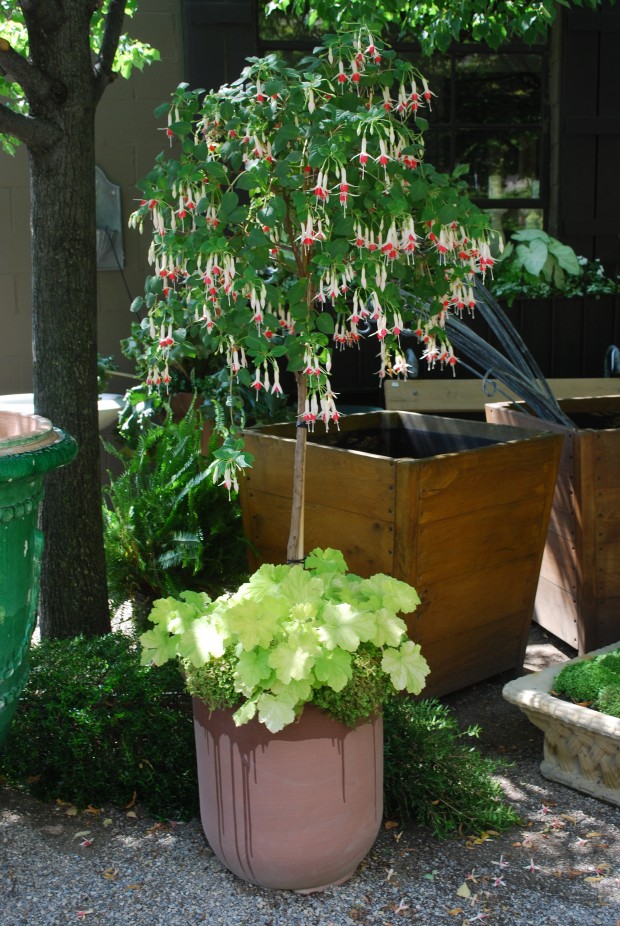 Fuchsia flowers may be small, but they have a very interesting shape, and come in a wide range of colors. A fuchsia on standard makes a great centerpiece in a container planted for shade. This fuchsia “Ballerina” will flower next to a north wall, all summer long.
Fuchsia flowers may be small, but they have a very interesting shape, and come in a wide range of colors. A fuchsia on standard makes a great centerpiece in a container planted for shade. This fuchsia “Ballerina” will flower next to a north wall, all summer long.
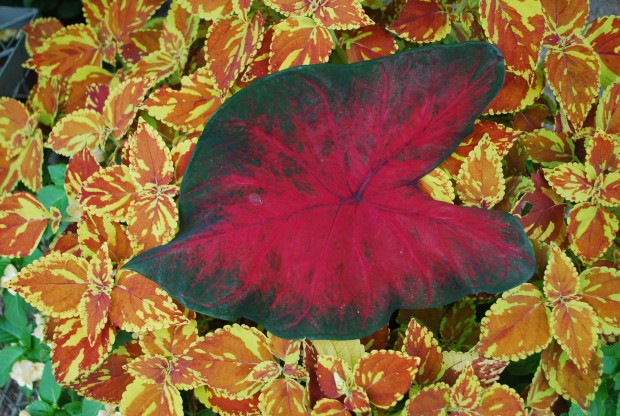 Few shade tolerant annuals can rival coleus and caladiums for dramatic color and form. For many years coleus did not interest me that much. The colors looked so muddy. New cultivars have very clear and vibrant colors. They old standard caladiums have a lot more company these days. The arrow and strap leaf caladiums have a saucy shape, and are visible from quite a distance. The new white cultivars are very bright in shady locations.
Few shade tolerant annuals can rival coleus and caladiums for dramatic color and form. For many years coleus did not interest me that much. The colors looked so muddy. New cultivars have very clear and vibrant colors. They old standard caladiums have a lot more company these days. The arrow and strap leaf caladiums have a saucy shape, and are visible from quite a distance. The new white cultivars are very bright in shady locations. 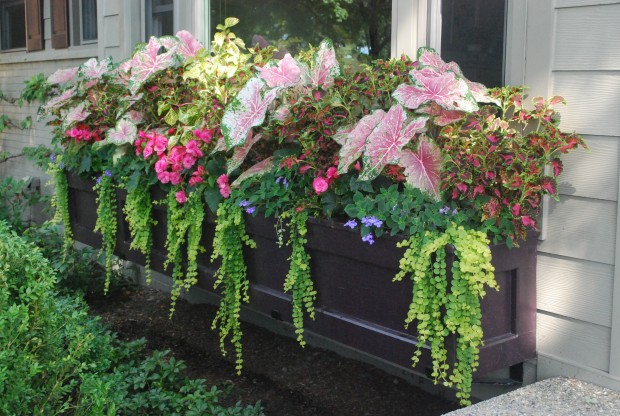 Variety is the spice of life, yes? In my opinion, the planting in this window box is much more visually interesting than a mass of impatiens. A good design assembles a collection of materials that look good together. Sometimes, the relationship between one element and another is vastly more interesting that the individual element alone. I do understand that there is a financial aspect to the impatiens debacle. An impatiens plant runs between .25 and .40 each. A single 4″ pot of coleus is 10 times that much. But many growers are offering coleus and seed New Guinea impatiens in flats. Some larger growing shade annuals can be found in 6 packs-18 plants to a flat. Other alternatives? Take the most ordinary white fibrous begonias in flats, and plant them in interesting shapes, swirls and stripes. Make the statement with a shape, rather than a specific variety. Impatiens has a tendency to get massive and shapeless by summer’s end. A planting of white or pick or red fibrous begonias can hold an intricate shape or pattern. A mix of three colors is more sparkly and interesting than one color. Those begonias can be punctuated with a 4″ pot of some other shade tolerant annual every so often. Another tip-fibrous begonias with dark leaves have a dour muddy look-stick with the green leaved varieties, unless you have a whole “other than green” foliage idea in mind.
Variety is the spice of life, yes? In my opinion, the planting in this window box is much more visually interesting than a mass of impatiens. A good design assembles a collection of materials that look good together. Sometimes, the relationship between one element and another is vastly more interesting that the individual element alone. I do understand that there is a financial aspect to the impatiens debacle. An impatiens plant runs between .25 and .40 each. A single 4″ pot of coleus is 10 times that much. But many growers are offering coleus and seed New Guinea impatiens in flats. Some larger growing shade annuals can be found in 6 packs-18 plants to a flat. Other alternatives? Take the most ordinary white fibrous begonias in flats, and plant them in interesting shapes, swirls and stripes. Make the statement with a shape, rather than a specific variety. Impatiens has a tendency to get massive and shapeless by summer’s end. A planting of white or pick or red fibrous begonias can hold an intricate shape or pattern. A mix of three colors is more sparkly and interesting than one color. Those begonias can be punctuated with a 4″ pot of some other shade tolerant annual every so often. Another tip-fibrous begonias with dark leaves have a dour muddy look-stick with the green leaved varieties, unless you have a whole “other than green” foliage idea in mind. 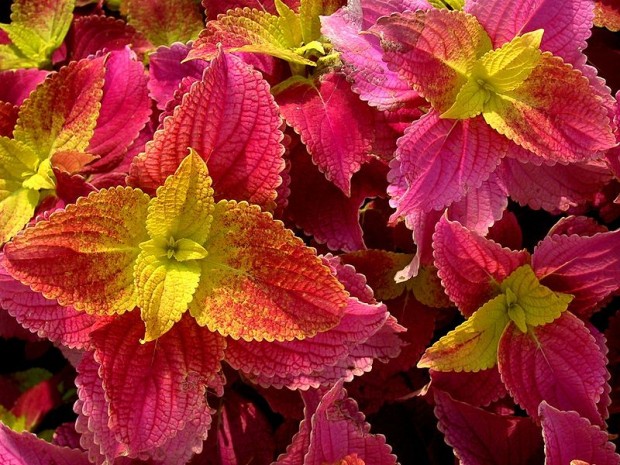 But the best of this bad situation is a chance to become acquainted with plants you may have passed by before. There are some very beautiful plants out there, looking for a home for the summer.
But the best of this bad situation is a chance to become acquainted with plants you may have passed by before. There are some very beautiful plants out there, looking for a home for the summer.
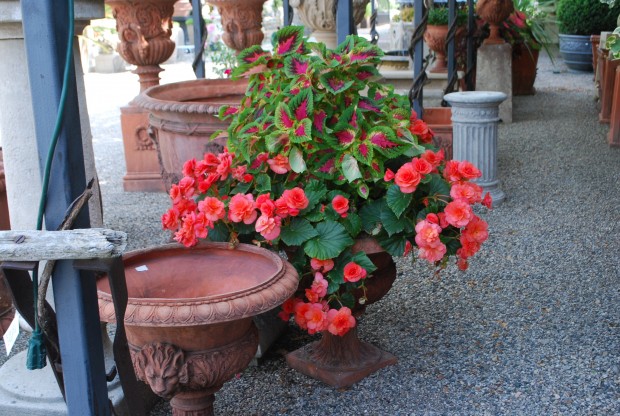 coleus and solenia orange begonias
coleus and solenia orange begonias
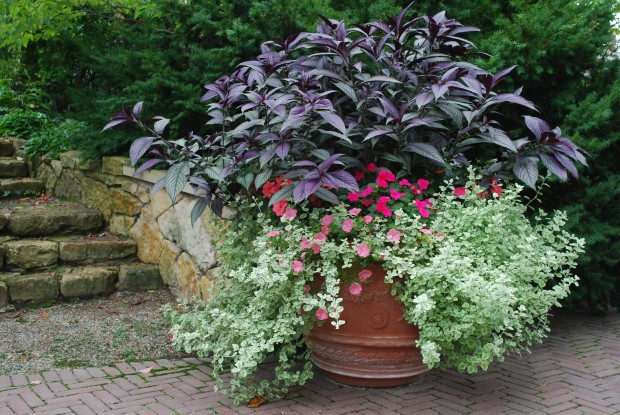 This container does have a dash of color courtesy of a blob of lipstick impatiens. But that impatiens is by no means the star of this show.
This container does have a dash of color courtesy of a blob of lipstick impatiens. But that impatiens is by no means the star of this show.


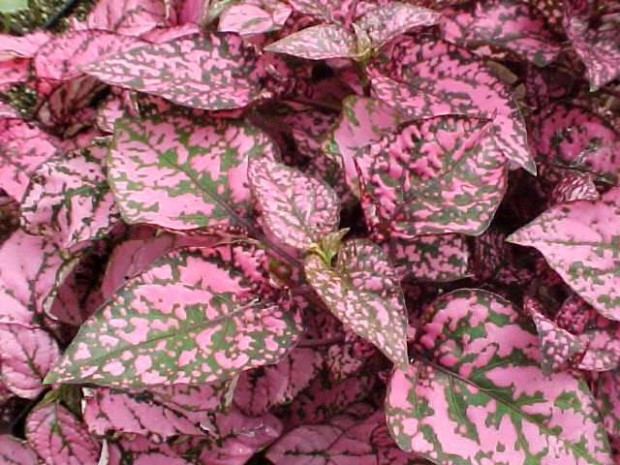
Thanks so much for sharing the warning and providing beautiful alternatives. I cannot do without the beautiful silvery purple Persian Shield.
Nella, Trouble has its upside. It encourages gardeners to be more creative. The feeling that comes with being creative-the best.
Thank you for such a nice summary of both the problem & the solutions available. I’d like to share this on my blog, if you don’t mind.
Share away. I would only want for every gardener to have a good summer season.
It’s as if you were reading my mind. The last three seasons have been a descent into impatiens hell. Three years ago — “what did we do wrong?”; two years ago — “something is is seriously wrong with the impatiens”; last season — “this disease thing is serious…we need to plant something different next season.”
Well….it is next season. I have been thinking about this all week and was planning on posting this question to you…et voilà.
We regularly plant huge bends of white impatiens in big color blocks to essentially create light fields in dark places. (Between 25 and 30 flats…we are usually crying by the time we get to the last flat.) but we haven’t decided what to do yet. I was thinking of playing with similar shapes and planting gigantic elephant ears as background to those white caladiums which looks like they have fireworks exploding on them. When I priced out the caladiums (or is it caladia?) last week I realized that I would spending a pretty penny. But what price beauty, he asked?
I may just go with huge beds of chartreuse coleus. I want something that get tall and bushy like the impatiens did. By the end of the summer those what beds of impatiens would take your breathe away.
May they rest in peace to rise again one day.
Michael, I hope the impatiens crisis will pass. I so hope. The future is really cloudy right now. Looking for a great tall and bushy chartreuse coleus? The cultivar Wasabi is the best I have ever seen. You will not be disappointed. Space those wasabi coleus a fair distance apart. They grow. Deborah
Wonder how the self-seeding impatiens are tolerating the problem? Will ask around here.
Nope, no go in our zone 8 for impatiens in the sun. Love the self-seeders in shady backyards with plenty of space to become decadent.
Oooooh the glimpses of your nursery. Wish I lived closer for clients to buy from you but glad I’m not closer to buy from you personally !! Love all I see.
Garden & Be Well, XO TAra
Tara, when are you coming? XO Deborah
I didn’t realize the Impatiens problem was nation-wide. I live in Atlanta, Georgia and tried to plant Impatiens three separate times last year in my container gardens, only to lose them within a month. I finally figured out they had powder mold. I went back to the nursery I purchased them from and discovered all their Impatiens suffered from the same mold. I emptied the soil and tried again this year. So far they look pretty good. I haven’t noticed any mold whatsoever but I’m watching them closely. Thanks for the heads-up in your post.
Dear Joni, this disease devastated Europe, and then Florida. It is spreading. I know that impatiens I planted in 2009 were infected-I just didn’t catch on. It is not clear how this will resolve itself. But for sure, the fungus is airborne. Impatiens that are grown under very strict controls can be infected by a diseased plant down the street. I am not the gardener who sprays chemicals. I would rather not plant them, than spray and spray again. I hope the fact that you replaced the soil makes a difference. But airborne infection-how can you protect yourself from that? Deborah
Disappointed any grower is selling these. It’s a problem we could make go away if everyone was on the same page. Thanks for writing this and suggesting great alternatives.
Keyjay, I too am disappointed in any grower that is selling impatiens. That said, the issue is far more complicated. Growers who rely on the good sales of flats of impatiens still have employees to pay. Extraordinary heating bills. The cold and lack of sun this spring-devastating to the people who grow plants for a living. The impatiens problem-one more very troubling issue. Growers, like you, have mortgage payments that come due, and kids to educate. The idea that a greenhouse needs to eliminate a plant whose sale helps them live a decent life-devastating. People who grow plants-I so respect them. The impatiens disease affects them so much more than any gardener. The process of making a major disease go away-not so easy. I hope some solutions are not so far away. Deborah
Thanks coach !!
I know coleus Wasabi and like it a lot. Let me know if you have any other great ideas.
I planted all our window boxes last year at the beach house 3XXXX.. And it drove me crazy I could not imagine what was wrong and have since read all the information about the mildew Begonias will be my go to this summer
I will still miss the inpatients 🙁
Very good summation of the Impatiens problem Deborah. Michigan will indeed, be particularly hard-hit by this as we are one of the top producers of Impatiens in the nation. Your ideas about alternatives are terrific and I appreciate your important point that we should tap into our creativity to find new plants to color our world. I am exploring tuberous begonias this year in our garden and have had good luck over-wintering tubers so far. I’ve seen these showy flowers at Butchart and Minter Gardens in B.C. and at Hampton Court displayed to their very best advantage and I am excited to learn more about the many varieties available and how they can provide head-turning color ribbons in our shady borders and containers. Then there’s Coleus…
Julia, your enthusiasm is such a pleasure. I can’t wait to see what gardeners will do.
Fibrous-rooted Wax Begonias are tough and hearty and oh, so pretty. They’re only in red, pink and white but a choice of green or bronze foliage. My other easy fav is Alternanthera.
you grow alts in the shade?? I have only tried the red leaved variety-which is very shade tolerant. We don’t see them much around here, as you can’t count on getting enough consistent heat.
Deborah: Thanks for this very good post with lots of information. I just put on my Pinterest Garden board…everyone needs to know about this! And yes, I still see flats of them sold here in N.C…..
Libby, There are people growing them here too. I do believe that the quickest way to eradicate the disease is for everyone to quit growing it. It may be that the march of the disease will have to get worse and more obvious before people are ready to cooperate about this. Deborah
Impressed that you comment about comments so frequently, Deborah. Don’t want to hijack your post here and I agree it is a complicated issue, but growers need to re-tool and grow something else — can’t keep doing something if it turns out to be a bad something. It’s not like we won’t buy alternatives and I personally would tend to FAVOR a grower or a greenhouse that was doing the right thing, so they might actually get more business. I’m just sayin.
What you’re saying is right. Some of our big nurseries have quit growing them altogether-and I hope more will follow suit.
The saleslady at the nursery where I got my impatiens seed told me about the disease in February. She said that it was good that I was growing seeds because there was some disease infecting impatiens, so I guess it was already a known issue…
But I wasn’t aware the seed itself could be infected. The seeds are now awaiting germination. If this can infect other plants, maybe I should just chuck the whole pile?
I was just trying new annuals for a lark since I normally don’t plant them. I’d hate to endanger my other plants for no reason. What do you think?
the disease does not spread to other plant species-it is specific to impatiens walleriana. There are some who feel the seed is infected-others do not. Grow you plants from seed-but keep an eye on them. If they develop the fungus, pull them out, and put them in the trash.
Dear Deborah, I am in love with your blog, your pics, your talent, everything! I live on the opposite side of the state, Holland, MI; and just discovered your website/blog/business. Planting/gardening/plant containers is my love. I unexpectedly won runner-up for Holland Container Contest last year (four runner-ups, and two tied first prize winners) for the City of Holland..Anyway, I am so glad to have read your blog about impatiens. I am not fond of the annual and appreciate you and others’ comments about “variety is the spice of life”. Yes! Beautiful, beautiful arrangements posted!
Question: How many Persian Silver Shield do you plant to obtain the fullness as shown on the pic on this blog? I would like to plant this annual for the first time in two of my larger containers. Please advise. I may just make a trip to your nursery! Thank you in advance for your response.
Dear Fernando, thanks for all of your enthusiasm! I truly appreciate it. I put 3 Persian Shield in the center of that container-rootball to rootball. The container is 42 ” across, at the top. Deborah
This year I thought I would try the sun impatiens. All was well until a few days ago when I noticed that they seemed to be having the same issued (mold) as my flowers did last year. I was so disappointed, I thought that the sun impatiens are resistant to that mold. Next year I will be trying something else. Does anyone know if using the same containers had an effect on the flowers this year?